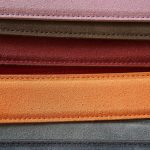To fix your lawn chair fabric, first check for tears, holes, or weak spots by feeling and examining the material closely. Gather tools like scissors, heavy-duty needles, matching fabric patches, and strong thread or fabric glue. For small tears, clean and apply patches securely; for heavily worn fabric, carefully remove and replace it with durable, weather-resistant material. Secure new fabric tightly to the frame to avoid sagging. Keep taking proper care to extend the chair’s life and discover additional helpful tips ahead.
Table of Contents
Key Takeaways
- Inspect the fabric for tears, holes, and weak spots, focusing on seams and weight-bearing areas before starting repairs.
- Use matching fabric patches and fabric glue or sew small tears promptly to prevent damage from spreading.
- Remove and replace worn or stretched fabric with durable, weather-resistant material cut to size for a secure fit.
- Attach new fabric tightly to the frame using heavy-duty staples, starting from the center and working outward evenly.
- Maintain repaired fabric by storing the chair indoors or covered, cleaning gently, and avoiding dragging or extreme temperatures.
Assessing the Damage on Your Lawn Chair Fabric
Before you jump into repairs, take a close look at your lawn chair fabric to figure out the extent of the damage.
Check for tears, holes, frayed edges, or areas where the material has weakened. Run your fingers gently over the fabric to spot thin spots that mightn’t be obvious at first glance.
Make note if the damage is localized or spread across multiple sections. Also, inspect the stitching to see if any seams have come undone.
Understanding the damage helps you decide whether a simple patch will do or if a full replacement is necessary. Taking this step guarantees you won’t waste time fixing parts that aren’t salvageable and helps you plan your repair approach efficiently.
Gathering Necessary Tools and Materials
Before you start fixing your lawn chair, make certain you have the right tools like scissors, a sewing kit, and pliers.
Choose fabric that matches your chair’s material to guarantee a seamless repair.
Don’t forget adhesives or fasteners that work well with outdoor fabrics to keep everything secure.
Essential Repair Tools
Gathering the right tools makes fixing your lawn chair fabric much easier and guarantees a durable repair.
Start with a sturdy pair of scissors to trim frayed edges and cut patches precisely. You’ll need a heavy-duty needle or upholstery needle that can handle thick fabric and multiple layers. Strong thread, like polyester or nylon, guarantees your stitches won’t easily break.
A seam ripper helps remove damaged fabric without harming the chair frame. Fabric glue or adhesive tape designed for outdoor materials can provide a quick fix or reinforce seams.
Finally, keep clamps or binder clips handy to hold fabric in place while you sew or glue. Having these essential tools ready lets you tackle repairs efficiently and get your chair back in shape.
Fabric Types Needed
Since the fabric is the main component of your lawn chair, choosing the right type is crucial for a lasting repair.
You’ll want a material that’s durable, weather-resistant, and comfortable. Look for outdoor fabrics like polyester, vinyl, or acrylic—these resist fading and mildew.
If your chair originally had mesh fabric, find a similar breathable material to maintain comfort. Measure the damaged area carefully to buy enough fabric, including extra for folding and securing edges.
Avoid indoor fabrics, as they won’t withstand sun or rain. Also, consider color and pattern to match or refresh your chair’s look.
Having the correct fabric on hand will simplify the repair process and guarantee your lawn chair stays sturdy and attractive for seasons to come.
Adhesives and Fasteners
When repairing your lawn chair fabric, you’ll need the right adhesives and fasteners to guarantee a secure and lasting fix.
Choose a strong, weather-resistant fabric glue designed for outdoor use; it bonds well to synthetic and canvas materials without stiffening the fabric. For quick fixes, fabric tape or iron-on patches can be handy, but confirm they’re suitable for outdoor conditions.
If your repair involves reattaching fabric to the frame, gather stainless steel screws or rivets to prevent rusting. A heavy-duty stapler with weatherproof staples also works well for securing fabric edges.
Have a pair of sharp scissors, a screwdriver, and pliers ready to help you handle fasteners efficiently.
Using the appropriate adhesives and fasteners will keep your lawn chair fabric durable and comfortable for seasons to come.
Repairing Small Tears and Holes
First, you’ll want to carefully inspect your lawn chair fabric to spot any small tears or holes.
Next, choose the right repair materials that match the fabric type and color.
Finally, follow a simple step-by-step process to mend the damage and restore your chair’s comfort and appearance.
Identifying Fabric Damage
You’ll want to carefully examine your lawn chair fabric to spot any small tears or holes before they worsen.
Catching damage early makes repairs easier and extends your chair’s life. Here’s how to identify fabric damage effectively:
- Visual Inspection: Look closely for any irregularities, like frayed edges, thin spots, or tiny holes. Bright sunlight helps reveal subtle flaws.
- Touch Test: Run your fingers over the fabric to feel for weak areas or small splits that may not be immediately visible.
- Check Stress Points: Focus on seams and areas that bear the most weight, as these spots are prone to developing tears over time.
Choosing Repair Materials
Although small tears and holes might seem minor, choosing the right repair materials is crucial to restoring your lawn chair fabric’s durability and appearance.
Start by selecting a patch material that closely matches your chair’s fabric in both texture and color; outdoor vinyl or heavy-duty polyester patches work best for most lawn chairs.
You’ll also need a strong adhesive designed for outdoor fabrics, such as a waterproof fabric glue or specialized vinyl adhesive, to guarantee the patch stays secure through weather changes.
For extra strength, consider fabric repair tape, which offers a quick, no-mess solution.
Avoid using regular household glue or tape, as they won’t hold up well outside.
Picking the right materials upfront sets you up for a long-lasting, neat repair.
Step-by-Step Mending Guide
Before you plunge into repairs, make sure the fabric is clean and dry to help the adhesive bond properly.
Here’s a simple step-by-step guide to mend small tears and holes in your lawn chair fabric:
- Trim Loose Threads: Carefully cut away any frayed edges around the tear to create a smooth surface.
- Apply Patch and Adhesive: Place a patch slightly larger than the hole underneath the fabric. Use fabric glue or adhesive tape designed for outdoor materials to secure it.
- Press and Cure: Press the area firmly, smoothing out wrinkles or bubbles. Let it cure as per the adhesive instructions—usually several hours.
Following these steps will restore your chair’s fabric strength and extend its life without needing a full replacement.
Replacing Worn or Stretched Fabric
Replacing worn or stretched fabric on your lawn chair can breathe new life into its comfort and appearance.
First, inspect the fabric thoroughly to identify areas that are too stretched or weakened. Remove the old fabric carefully, guaranteeing you don’t damage the frame. Measure the existing fabric or the seating area to determine the correct size for the replacement.
Choose durable, weather-resistant material that matches your chair’s style and intended use. Cut the new fabric according to your measurements, allowing extra inches for securing it later. If the original fabric had any specific patterns or reinforcements, replicate those to maintain strength and comfort.
Taking these steps guarantees your lawn chair remains both functional and visually appealing before you attach the new fabric to the frame.
Attaching New Fabric to the Frame
Once you have your new fabric cut to size, you’ll want to secure it firmly to the frame to confirm durability and comfort. Here’s how to attach it properly:
- Align and Position: Place the fabric onto the frame, making sure it’s centered and smooth. Avoid wrinkles to confirm a neat finish.
- Secure with Clips or Staples: Use heavy-duty staples or clips along the edges, starting from the center and working outwards. Pull the fabric taut as you go to prevent sagging.
- Reinforce Stress Points: Pay extra attention to corners and areas that bear weight. Add extra staples or sew reinforcements if needed to prevent future tears.
Following these steps helps your lawn chair fabric stay secure and comfortable for seasons ahead.
Tips for Maintaining Lawn Chair Fabric Longevity
After securing new fabric to your lawn chair, keeping it in good shape will extend its life and maintain comfort.
Always store your chair indoors or under a waterproof cover when not in use to protect it from sun, rain, and dirt.
Store your chair indoors or under waterproof cover to shield it from sun, rain, and dirt when not in use.
Clean the fabric regularly with mild soap and water to prevent buildup of grime and mildew. Avoid harsh chemicals that can weaken fibers.
Check for loose stitching or small tears and repair them promptly to stop damage from spreading.
When moving the chair, lift it instead of dragging to prevent unnecessary stress on the fabric.
Finally, avoid exposing your chair to extreme temperatures, which can cause fabric to fade or crack.
These simple steps will keep your lawn chair fabric looking fresh and durable for seasons to come.
Frequently Asked Questions
Can I Use Outdoor Paint to Refresh Faded Lawn Chair Fabric?
You can use outdoor paint to refresh faded lawn chair fabric, but be sure to choose fabric-specific or flexible paint. Test a small area first to avoid stiffness or cracking, and let it dry thoroughly before use.
How Do I Clean Mildew off Lawn Chair Fabric Safely?
You might worry about harsh chemicals, but you can safely clean mildew by scrubbing the fabric with a mix of water, mild detergent, and white vinegar. Rinse well, then let it dry completely in the sun.
Are There Specific Fabrics Better for Lawn Chairs in Rainy Climates?
You’ll want to choose fabrics like solution-dyed acrylic or polyester—they resist water, mildew, and fading. These materials dry quickly and hold up well in rainy climates, keeping your lawn chairs durable and comfortable.
Can I Machine Wash Lawn Chair Fabric Covers?
You can machine wash lawn chair fabric covers if the care label allows it. Use a gentle cycle with cold water and mild detergent. Avoid harsh chemicals and always air dry to prevent damage or shrinking.
How Do I Store Lawn Chairs to Prevent Fabric Damage?
You should store your lawn chairs in a dry, shaded area to prevent fabric damage. Use chair covers or store them indoors during harsh weather. Make sure the fabric is clean and completely dry before storing to avoid mold.
- Does Chiffon Fabric Stink - July 15, 2025
- Does Chiffon Fabric Affect the Economy - July 15, 2025
- Does Cotton Fabric Have a Nap - July 15, 2025







